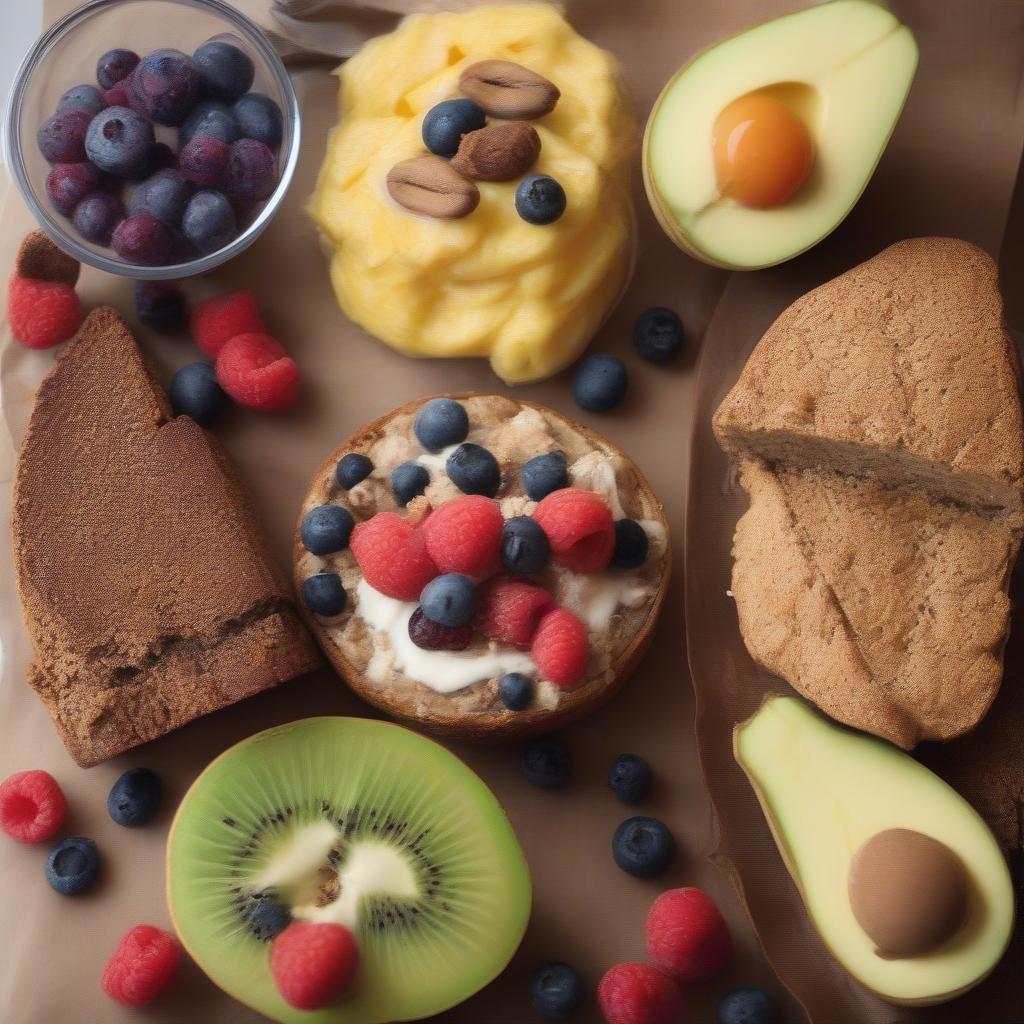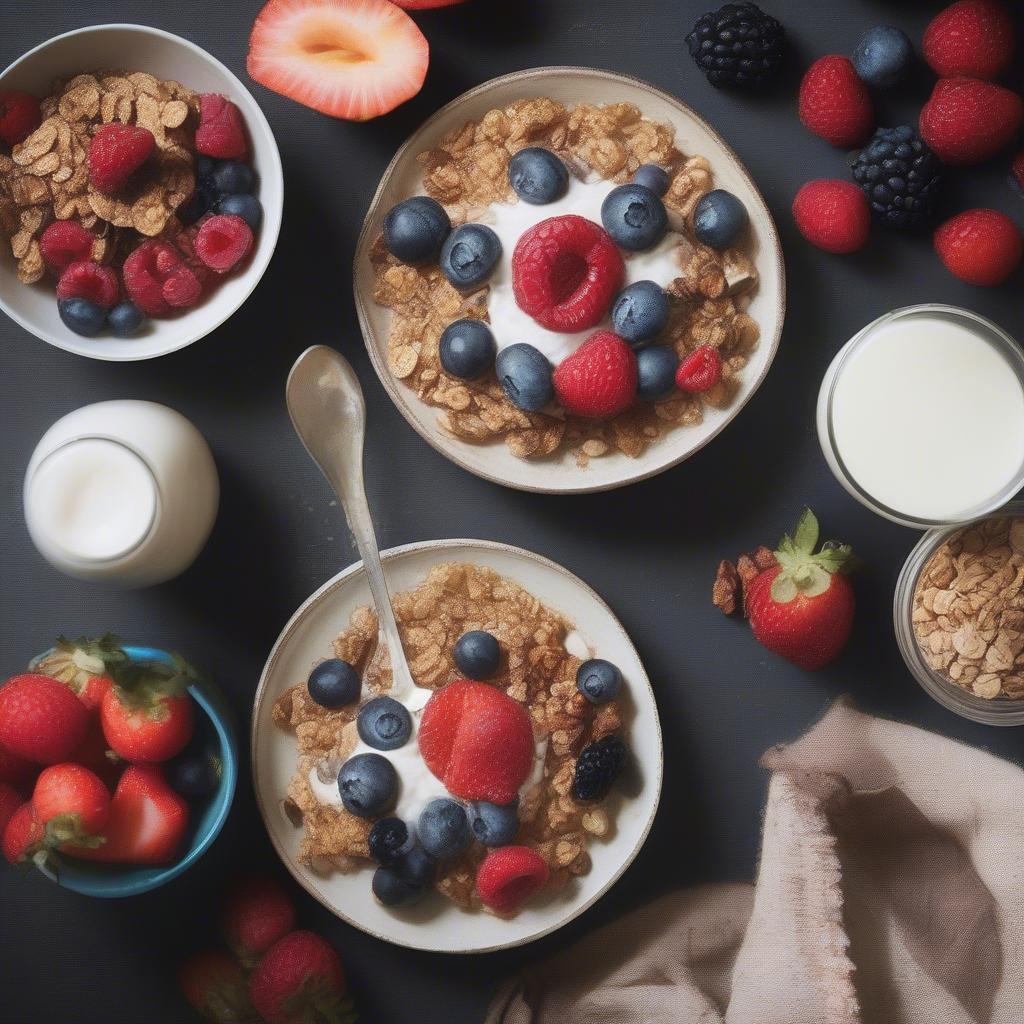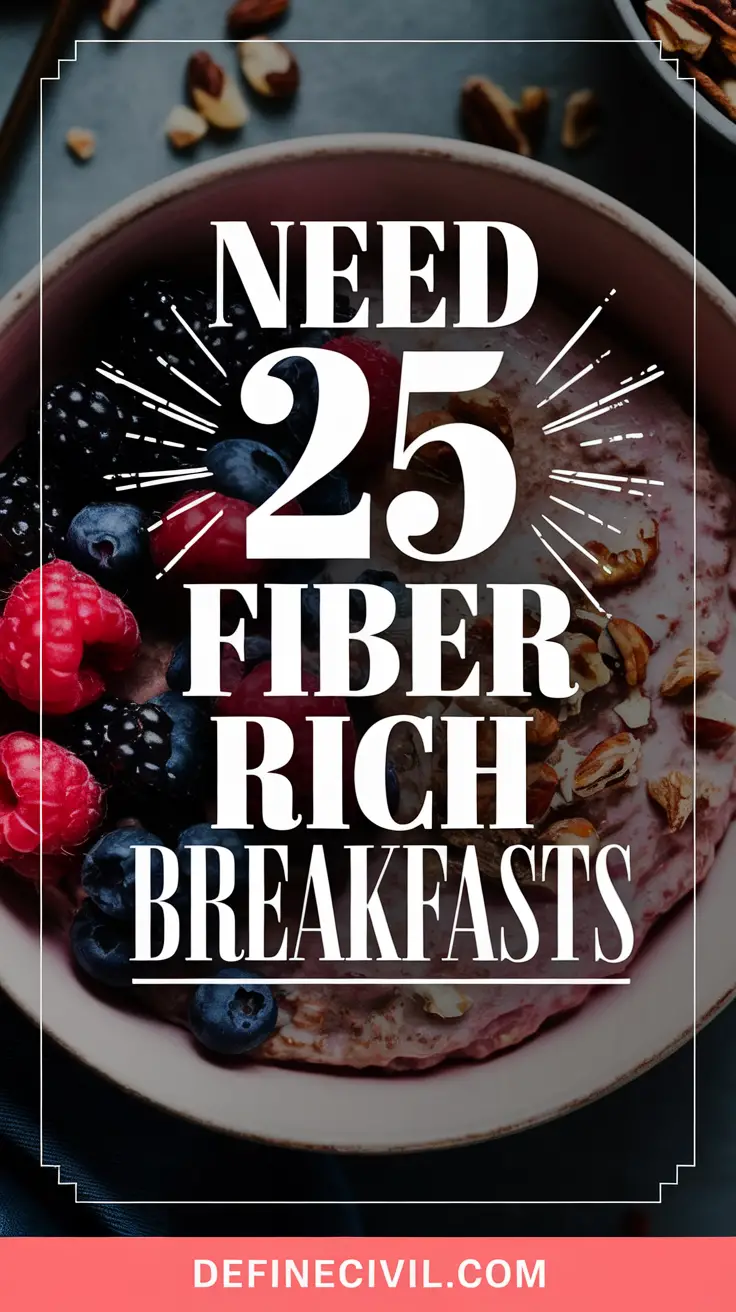
Wellness Nutrition: 25 High-Fiber Breakfasts to Try for Good Gut Health
By Jillian Kubala, RD
Jillian Kubala, MS, is a registered dietitian based in Westhampton, NY. Jillian uses a unique and personalized approach to help her clients achieve optimal wellness through nutrition and lifestyle changes.
Introduction
Getting enough fiber in your diet is important for overall health. Unfortunately, most people’s diets are too low in this critical nutrient, which can increase the risk of diseases such as colon cancer, heart disease, and diverticulitis. Fortunately, there are plenty of ways to boost your fiber intake, including starting your day with a fiber-rich breakfast. Here are 25 fiber-packed breakfast ideas that can boost digestive health.
High-Fiber Breakfast Ideas
1. Avocado Toast with Hemp Seeds
Avocados are an excellent source of fiber, delivering 13.5 grams of fiber per avocado. Topping a piece of high-fiber, whole grain, or gluten-free slice of toast with smashed avocado is a quick and easy way to fuel your body in the morning when you’re in a hurry. Sprinkle your toast with an ounce of toasted sunflower for an extra 3.36 grams of fiber.
2. Chia Pudding
Chia seeds are exceptionally high in fiber, providing nearly 10 grams per ounce. Chia seeds can help promote healthy bowel movements and ease digestive symptoms like constipation. Chia pudding is a delicious, high-fiber breakfast or snack idea that can be whipped up in seconds. Simply combine two tablespoons of chia seeds with a half-cup of milk of your choice and let the mixture sit in the refrigerator until it takes on a pudding-like consistency.
3. Oatmeal with Sliced Almonds and Berries
Many people start their day with a warm bowl of oatmeal. Oatmeal is high in fiber on its own, packing nearly 4 grams per cup, but is often combined with other fiber-rich ingredients, such as fruit and nuts. Try topping your morning oats with blackberries and sliced almonds for a filling breakfast idea.
4. Sweet Potato Toast
One large sweet potato provides nearly 6 grams of fiber, making it the perfect high-fiber vessel for savory ingredients like eggs, fiber-rich vegetables, and beans. Make sweet potato toast by thinly slicing a raw sweet potato and then roasting it in the oven at 400 degrees for 30 minutes.
5. Vegetable and Avocado Omelet
Combining protein-rich eggs with high-fiber ingredients like vegetables and avocado creates a filling breakfast option that’s sure to keep you satisfied until your next meal or snack. Protein and fiber both help improve feelings of fullness by slowing digestion and stimulating the release of satiety hormones such as peptide YY (PYY) and cholecystokinin (CCK), which act on certain areas of the brain to inhibit food intake.
6. Quinoa Bowl with Eggs and Veggies
Quinoa is a gluten-free pseudocereal grain that’s rich in fiber, plant-based protein, folate, magnesium, zinc, and iron. Quinoa provides 5.18 grams of fiber per cup and can be made in bulk and stored in the refrigerator for a quick breakfast idea. Try topping cooked quinoa with eggs, cheese, vegetables, and beans for a savory meal.
7. Breakfast Salad
Though salads aren’t typically enjoyed at breakfast time, preparing a breakfast salad is a convenient and delicious way to boost your fiber intake. Simply top your favorite leafy greens, like mixed greens, arugula, or spinach, with hard-boiled eggs, cooked or raw vegetables, seeds, beans, cheese, and any other savory or sweet salad combinations you enjoy.
8. Protein Smoothie with Berries and Flax
When you’re short on time but don’t want to skip breakfast, try making a smoothie. Not only can smoothies be whipped up in minutes, but they can be tailored to your dietary needs and preferences. To increase the fiber content of your smoothie, add high-fiber berries, like frozen raspberries and blackberries, and ground flax seeds, which provide 8 grams of fiber per ounce.
9. Breakfast Tacos
Tacos aren’t just for lunch and dinner. Breakfast tacos are a tasty way to start your day and can be packed with fiber-rich ingredients like beans and vegetables. Try making breakfast tacos using soft or hard corn taco shells and stuffing them with eggs, sautéed vegetables, like onions and peppers, and black beans.
10. Shakshuka with Avocado
Shakshuka is a low-carb breakfast that’s high in fiber and protein. It’s a North African and Middle Eastern dish that’s made with eggs poached in a tomato- and vegetable-based sauce. Add extra vegetables, like peppers and onions, and top your shakshuka with sliced avocado for a fiber-packed, low-carb-friendly meal.
11. Smashed Beans on Toast
Beans on toast is a simple meal that can be enjoyed at any time of day, including breakfast. Traditional beans on toast is made by topping a slice of whole-grain, sourdough, or gluten-free toast with canned baked beans, preferably with no added sugar. Great Northern beans pack an impressive 12.8 grams of fiber per cup and can help you meet your daily fiber needs.
12. Savory Oatmeal with Eggs and Spinach
Savory oatmeal is a delicious twist on traditional oatmeal and can be made with fiber-rich ingredients. Try topping cooked oats, which are packed with 3.98 grams of fiber per cup, with eggs and sautéed vegetables like spinach or broccoli for a protein and fiber-rich savory breakfast option.
13. Vegan Sweet Potato and Chickpea Hash
If you’re following a plant-based diet or are looking for egg-free breakfast options, vegetable hash, like sweet potato and chickpea hash, is a good option. Chickpeas provide 12.5 grams of fiber and 14.5 grams of protein per cooked cup, making them a filling breakfast option.
14. Almond Flour Blueberry Muffins with Almond Butter
Unlike regular all-purpose flour, almond flour is rich in fiber, providing 8 grams of fiber per cup. Use almond flour in place of all-purpose flour in recipes like blueberry muffins to increase their fiber content. Enjoy your high-fiber muffins with a smear of almond butter for a boost of plant-based protein.
15. Smoothie Bowl
If you’re not a fan of drinking smoothies, try making a smoothie bowl. Smoothie bowls have a thicker texture than regular smoothies and can be enjoyed with a spoon. Top smoothie bowls made with protein powder and frozen berries with high-fiber ingredients like chia seeds and sliced almonds.
Tips for Getting More Fiber
Getting enough fiber on a daily basis is important for digestive health and can help reduce your risk of several health conditions, including digestive conditions like constipation and diverticulitis. Here are a few tips that can help you add more fiber to your diet:
- Add more fruits and vegetables to your diet.
- Top salads and grain dishes with high-fiber beans or lentils.
- Swap all-purpose flour for almond or coconut flour.
- Eat higher-fiber carbohydrates, like potatoes, oats, butternut squash, quinoa, and fruit.
- Snack on high-fiber foods, like vegetables dipped in hummus or guacamole and high-fiber smoothies.
- Add more nuts and seeds to your diet.
- Use chia and flaxseeds in baked goods, like muffins and breads.
- Enjoy more plant proteins, like beans and lentils.
Soluble vs. Insoluble Fiber
Fibers are categorized based on their solubility in water. Soluble fibers dissolve in water and can be fermented or broken down by bacteria that reside in your large intestine. This fermentation process releases gas and beneficial compounds called short-chain fatty acids (SCFAs), which benefit intestinal health by fueling the cells lining the colon, regulating inflammation, and strengthening the gut lining. Soluble fibers also support healthy blood sugar and cholesterol levels.
Unlike soluble fiber, insoluble fiber doesn’t dissolve in water and passes through your digestive system intact. Insoluble fiber adds bulk to stool and promotes healthy bowel movements. While most foods contain a combination of soluble and insoluble fibers, some foods are more concentrated in one type of fiber than the other. Foods rich in soluble fiber include broccoli, oats, fruits, and beans, while insoluble fiber is found in high amounts in nuts, cauliflower, whole grains, celery, and seeds.
A Quick Review
Starting your day with a fiber-rich breakfast is an easy way to take care of your health, including your digestive health. Choosing breakfast options like veggie-packed omelets, oatmeal, chia pudding, avocado toast, and yogurt parfaits can help you power through your busy morning while increasing your intake of fiber, protein, and other essential nutrients. What are the benefits of fiber in a breakfast diet? Getting enough fiber in your diet is important for overall health, reducing the risk of diseases like colon cancer, heart disease, and diverticulitis.
What are the benefits of fiber in a breakfast diet? Getting enough fiber in your diet is important for overall health, reducing the risk of diseases like colon cancer, heart disease, and diverticulitis.
How much fiber can avocado provide? One avocado can deliver 13.5 grams of fiber per avocado.
What makes chia pudding a high-fiber breakfast choice? Chia seeds provide nearly 10 grams of fiber per ounce, helping promote healthy bowel movements and ease digestive symptoms.
How does oatmeal contribute to fiber intake? Oatmeal is high in fiber, packing nearly 4 grams per cup, and can be combined with other fiber-rich ingredients like fruit and nuts.
How can sweet potato toast be high in fiber? A large sweet potato provides nearly 6 grams of fiber, making it ideal for savory toppings like eggs, vegetables, and beans.
What are the benefits of adding vegetables and avocado to an omelet? Combining vegetables and avocado with eggs provides a filling breakfast that improves feelings of fullness and digestive health.
How is quinoa beneficial in a breakfast bowl? Quinoa is gluten-free and rich in fiber, plant-based protein, and other essential nutrients, providing 5.18 grams of fiber per cup.
Can you make a breakfast salad? Yes, topping greens with eggs, cooked/raw vegetables, seeds, beans, cheese, and other ingredients makes a convenient, fiber-rich breakfast option.
How can you increase fiber content in a protein smoothie? Adding berries and ground flax seeds (8 grams of fiber per ounce) to a smoothie boosts fiber intake and can be tailored to dietary needs.
What’s unique about breakfast tacos? Breakfast tacos can be packed with fiber-rich ingredients like beans and vegetables, offering a tasty start to the day.
How does shakshuka incorporate fiber and protein? Shakshuka is a low-carb, fiber and protein-rich dish made with eggs poached in a tomato- and vegetable-based sauce, topped with sliced avocado.
What’s the fiber content in Great Northern beans? Great Northern beans provide 12.8 grams of fiber per cup, making them a filling fiber-rich breakfast option.
What is savory oatmeal with eggs and spinach? Savory oatmeal topped with eggs and sautéed vegetables like spinach or broccoli provides protein and fiber for a nutritious breakfast.
How does a vegan sweet potato and chickpea hash provide benefits? This vegan dish features chickpeas, which offer 12.5 grams of fiber and 14.5 grams of protein per cooked cup, making it a filling breakfast option.
Can almond flour be used to increase fiber in baked goods? Reusing almond flour in baked goods like blueberry muffins increases their fiber content to 8 grams per cup compared to regular all-purpose flour.
How do smoothie bowls differ from regular smoothies? Smoothie bowls have a thicker texture and can be enjoyed with a spoon, topped with high-fiber ingredients like chia seeds and sliced almonds.
What are the main tips for increasing daily fiber intake? Increase fruits and vegetables, add high-fiber beans or lentils to salads and grains, swap all-purpose flour, eat higher-fiber carbohydrates, snack on fiber-rich foods, add nuts and seeds, use chia and flaxseeds in baked goods, and Enjoy more plant proteins.
What are the differences between soluble and insoluble fiber? Soluble fiber dissolves in water, supporting digestive health, while insoluble fiber doesn’t dissolve, adding bulk to stool and promoting healthy bowel movements.
Which foods are rich in soluble fiber? Soluble fiber is found in high amounts in broccoli, oats, fruits, and beans.
Which foods are rich in insoluble fiber? Insoluble fiber is found in high amounts in nuts, cauliflower, whole grains, celery, and seeds.

